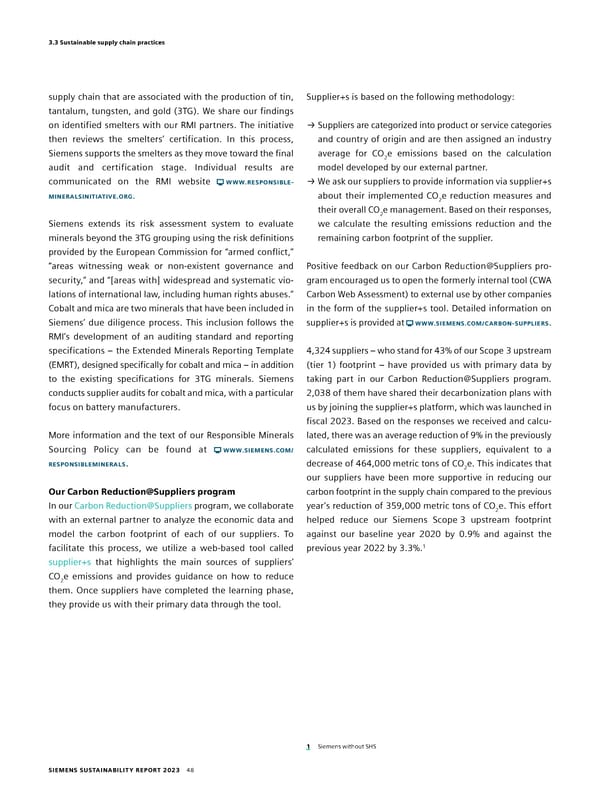3.3 Sustainable supply chain practices supply chain that are associated with the production of tin, Supplier+s is based on the following methodology: tantalum, tungsten, and gold (3TG). We share our findings on identified smelters with our RMI partners. The initiative → Suppliers are categorized into product or service categories then reviews the smelters’ certification. In this process, and country of origin and are then assigned an industry Siemens supports the smelters as they move toward the final average for CO2e emissions based on the calculation audit and certification stage. Individual results are model developed by our external partner. communicated on the RMI website WWW.RESPONSIBLE → We ask our suppliers to provide information via supplier+s MINERALSINITIATIVE.ORG. about their implemented CO e reduction measures and 2 their overall CO2e management. Based on their responses, Siemens extends its risk assessment system to evaluate we calculate the resulting emissions reduction and the minerals beyond the 3TG grouping using the risk definitions remaining carbon footprint of the supplier. provided by the European Commission for “armed conflict,” “areas witnessing weak or non-existent governance and Positive feedback on our Carbon Reduction@Suppliers pro- security,” and “[areas with] widespread and systematic vio- gram encouraged us to open the formerly internal tool (CWA lations of international law, including human rights abuses.” Carbon Web Assessment) to external use by other companies Cobalt and mica are two minerals that have been included in in the form of the supplier+s tool. Detailed information on Siemens’ due diligence process. This inclusion follows the supplier+s is provided at WWW.SIEMENS.COM/CARBONSUPPLIERS. RMI’s development of an auditing standard and reporting specifications – the Extended Minerals Reporting Template 4,324 suppliers – who stand for 43% of our Scope 3 upstream (EMRT), designed specifically for cobalt and mica – in addition (tier 1) footprint – have provided us with primary data by to the existing specifications for 3TG minerals. Siemens taking part in our Carbon Reduction@Suppliers program. conducts supplier audits for cobalt and mica, with a particular 2,038 of them have shared their decarbonization plans with focus on battery manufacturers. us by joining the supplier+s platform, which was launched in fiscal 2023. Based on the responses we received and calcu- More information and the text of our Responsible Minerals lated, there was an average reduction of 9% in the previously Sourcing Policy can be found at WWW.SIEMENS.COM/ calculated emissions for these suppliers, equivalent to a RESPONSIBLEMINERALS. decrease of 464,000 metric tons of CO2e. This indicates that our suppliers have been more supportive in reducing our Our Carbon Reduction@Suppliers program carbon footprint in the supply chain compared to the previous In our Carbon Reduction@Suppliers program, we collaborate year’s reduction of 359,000 metric tons of CO e. This effort 2 with an external partner to analyze the economic data and helped reduce our Siemens Scope 3 upstream footprint model the carbon footprint of each of our suppliers. To against our baseline year 2020 by 0.9% and against the 1 facilitate this process, we utilize a web-based tool called previous year 2022 by 3.3%. supplier+s that highlights the main sources of suppliers’ CO2e emissions and provides guidance on how to reduce them. Once suppliers have completed the learning phase, they provide us with their primary data through the tool. 1 Siemens without SHS SIEMENS SUSTAINABILITY REPORT 2023 48
 Sustainability Report Page 47 Page 49
Sustainability Report Page 47 Page 49